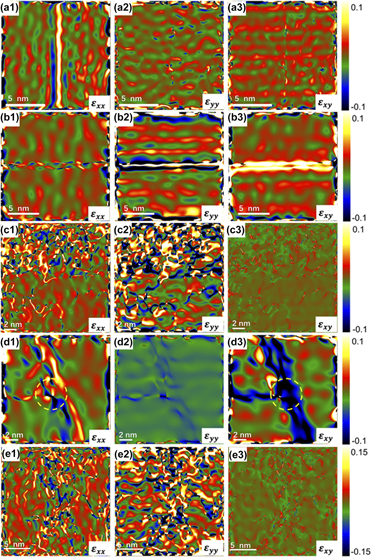Crossref Citations
This article has been cited by the following publications. This list is generated based on data provided by
Crossref.
Jandaghi, M.R.
Badini, C.
and
Pavese, M.
2020.
Dissimilar friction stir welding of AA2198 and AA7475: Effect of solution treatment and aging on the microstructure and mechanical strength.
Journal of Manufacturing Processes,
Vol. 57,
Issue. ,
p.
712.
Araujo, João Victor de Sousa
Silva, Rejane Maria Pereira da
Donatus, Uyime
Machado, Caruline de Souza Carvalho
and
Costa, Isolda
2020.
Microstructural, Electrochemical and Localized Corrosion Characterization of the AA2198-T851 Alloy.
Materials Research,
Vol. 23,
Issue. 4,
Shi, Chunchang
Wu, Guohua
Zhang, Liang
Zhang, Xiaolong
Sun, Jiangwei
Zhang, Jinshuo
and
Wang, Yixiao
2021.
Variation in the microstructure and mechanical properties of permanent mold cast Al–3Li–2Mg–0.1Zr alloy with Zn addition.
Journal of Materials Research,
Vol. 36,
Issue. 10,
p.
2071.
Yang, Yong
He, Guoai
Liu, Yu
Li, Kai
Wu, Wenke
and
Huang, Cheng
2021.
Quantitative contribution of T1 phase to the strength of Al-Cu-Li alloys.
Journal of Materials Science,
Vol. 56,
Issue. 33,
p.
18368.
LU, Ding-ding
LI, Jin-feng
NING, Hong
MA, Peng-cheng
CHEN, Yong-lai
ZHANG, Xu-hu
ZHANG, Kai
LI, Jian-mei
and
ZHANG, Rui-feng
2021.
Effects of microstructure on tensile properties of AA2050-T84 Al-Li alloy.
Transactions of Nonferrous Metals Society of China,
Vol. 31,
Issue. 5,
p.
1189.
Zhang, Yupeng
Lv, You
Liu, Ergen
Cai, Guangyi
Pan, Qinglin
Liu, Bing
Dong, Zehua
and
Zhang, Xinxin
2022.
Corrosion morphology evolution in 2A97-T6 Al-Cu-Li alloy: The influence of grain-stored energy.
Materials Characterization,
Vol. 191,
Issue. ,
p.
112169.
Klobes, Benedikt
Petschke, Danny
Lotter, Frank
Potapkin, Vasily
and
Staab, Torsten E. M.
2022.
The Li stance on precipitation in Al–Li-based alloys: an investigation by X-ray Raman spectroscopy.
Journal of Materials Science,
Vol. 57,
Issue. 11,
p.
6157.
Masoumi Khalilabad, Mahdi
Zedan, Yasser
Texier, Damien
Jahazi, Mohammad
and
Bocher, Philippe
2022.
Effect of heat treatments on microstructural and mechanical characteristics of dissimilar friction stir welded 2198/2024 aluminum alloys.
Journal of Adhesion Science and Technology,
Vol. 36,
Issue. 3,
p.
221.
Feng, Yifei
Chen, Xia
Hao, Yiqiang
Li, Xianzhuo
and
Chen, Bin
2022.
Coarsening mechanism of T1 precipitation and calculation of T1/Al interface properties in 2198 Al–Cu–Li alloys: Experimental and DFT studies.
Vacuum,
Vol. 204,
Issue. ,
p.
111333.
Freitas, L.R.
Gelamo, R.V.
Marino, C.E.B.
Nascimento, J.P.L.
Figueiredo, J.M.A.
Fernandes, J.C.S.
and
Moreto, J.A.
2022.
Corrosion behaviour of reactive sputtering deposition niobium oxide based coating on the 2198-T851 aluminium alloy.
Surface and Coatings Technology,
Vol. 434,
Issue. ,
p.
128197.
Hu, Wei
chen, jiqiang
Han, Shuang
Xu, Jinjun
Miao, Jiale
Xing, Ting
and
Guan, Renguo
2022.
An Initial Report on the Oriented-Precipitation of T1-Phase in Creep-Aged Al-Cu-Li Single Crystal.
SSRN Electronic Journal ,
Li, Jianyu
Pan, Yu
Wu, Shusen
Chen, Lu
Guo, Wei
Li, Shilong
and
Lü, Shulin
2023.
Precipitates strengthening mechanism of a new squeeze-cast Al–Cu–Li–Mn alloy with high strength and ductility.
Journal of Materials Research and Technology,
Vol. 25,
Issue. ,
p.
1334.
Hu, Wei
Chen, Jiqiang
Xu, Jinjun
Ren, Jieke
Miao, Jiale
Xing, Ting
Guan, Renguo
and
Ojo, Olanrewaju A.
2023.
Relationship between precipitation behavior and loading orientations of the creep-aged Al–Cu–Li single crystal.
Journal of Materials Research and Technology,
Vol. 24,
Issue. ,
p.
689.
Guo, Xuan
Wen, S.H.
Jiao, H.J.
and
Wu, S.J.
2023.
Effect of aging treatment on microstructure and mechanical properties of TIG welded joints of 2195-T8 Al-Li alloy.
Materials Characterization,
Vol. 196,
Issue. ,
p.
112576.
Examilioti, Theano N.
Li, Wenya
Kashaev, Nikolai
Ventzke, Volker
Klusemann, Benjamin
Tiryakioğlu, Murat
and
Alexopoulos, Nikolaos D.
2023.
On anisotropic tensile mechanical behavior of Al–Cu–Li AA2198 alloy under different ageing conditions.
Journal of Materials Research and Technology,
Vol. 24,
Issue. ,
p.
895.
Hu, Wei
Chen, Jiqiang
Han, Shuang
Xu, Jinjun
Miao, Jiale
Xing, Ting
and
Guan, Renguo
2023.
Initial Report on the Oriented-precipitation of T1-Phase in Creep-Aged Al-Cu-Li Single Crystal.
Metals and Materials International,
Vol. 29,
Issue. 5,
p.
1382.
Han, Chao
Yu, Mei
Jia, Xuejiao
Zhao, Zhenjiang
Zhang, Chuangchuang
Xiao, Jian
Li, Songmei
and
Liu, Jianhua
2024.
Effect of inhomogeneous microstructures on stress corrosion cracking sensitivity of 2050-T84 Al-Li alloy thick plate.
Corrosion Science,
Vol. 235,
Issue. ,
p.
112213.
Ning, Yaru
Ding, Lipeng
Liu, Suya
Ehlers, Flemming J.H.
Yang, Qingbo
Weng, Yaoyao
Zhang, Ke
Wang, Chenglin
and
Jia, Zhihong
2024.
Mutually separated, branched segregation behavior of Mg and Ag elements in the T1 precipitates of Al-Cu-Li alloys.
Scripta Materialia,
Vol. 252,
Issue. ,
p.
116270.
Wang, Meiqi
Yan, Lizhen
Li, Xiwu
Zhang, Yongan
Li, Zhihui
Wen, Kai
Liu, Hongwei
and
Xiong, Baiqing
2024.
Influence of Zn Addition on the Aging Precipitate Behavior and Mechanical Properties of Al-Cu-Li Alloy.
Materials,
Vol. 17,
Issue. 7,
p.
1562.
Kermanidis, Alexis T.
Charalampidou, Christina-Margarita
Goulas, Ioannis
Skarvelis, Panagiotis
and
Alexopoulos, Nikolaos D.
2024.
Fatigue and fracture behaviour of (Al-Cu-Li) AA2198 under different ageing conditions.
International Journal of Fatigue,
Vol. 184,
Issue. ,
p.
108286.

 ${\left( {0001} \right)_{{{\rm{T}}_1}}}//{\left\{ {111} \right\}_{{\rm{Al}}}}$,
${\left( {0001} \right)_{{{\rm{T}}_1}}}//{\left\{ {111} \right\}_{{\rm{Al}}}}$,  ${\left\langle {1010} \right\rangle _{{{\rm{T}}_{\rm{1}}}}}//{\left\langle {110} \right\rangle _{{\rm{Al}}}}$ and may have different kinds of multilayered structures. In most of the multilayered structures, the distance between two adjacent copper-rich laths is less than that in classical single-layered phase. Thus, it can be inferred that the microstructure of T1 phase might change in the process of developing from single-layered structure to multilayered structure. In addition, the interactions between different phases become relatively frequent when the density of T1 phase reaches a threshold.
${\left\langle {1010} \right\rangle _{{{\rm{T}}_{\rm{1}}}}}//{\left\langle {110} \right\rangle _{{\rm{Al}}}}$ and may have different kinds of multilayered structures. In most of the multilayered structures, the distance between two adjacent copper-rich laths is less than that in classical single-layered phase. Thus, it can be inferred that the microstructure of T1 phase might change in the process of developing from single-layered structure to multilayered structure. In addition, the interactions between different phases become relatively frequent when the density of T1 phase reaches a threshold.